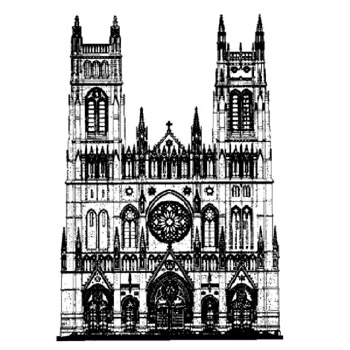
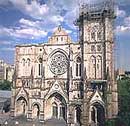 At Present
At Present
by

 At Present
At Present
In 1992 I had the honor and pleasure of working with master stonecarver Simon Verity who was then carving the statues at the Portal of Paradise, the front entrance to the beloved Cathedral Church Of St. John The Divine in New York City. At that time, the Cathedral had been under construction for over a century, since the 19th century, and it should be completed later in this 21st century. The above drawing depicts how it is intended to appear when finished. Like any well-designed Cathedral, it appears not only to be standing on the ground, but rightfully hanging down from heaven. Here is the Wikipedia article describing the Cathedral, its context and its history.
My role was to study the uncarved blocks of limestone on the south side of the portal and suggest a geometric theme which would allow these blank blocks to be carved into statues which would be harmoniously integrated with each other and with the entire building, including the space approaching the Cathedral. Rather than impose anything, I sought to discover what the architect had originally intended, speaking to us through the timeless language of mathematics, number and shape. I measured the group of upright blocks and realized that they formed a square-root-of-3 rectangle and that it was proportionally integrated with the facade and the space in front of the building. I presented Simon with the unique geometric possibilities of this ratio in the context of the Cathedral, in three dimensions. In this photo you can see some of the lines of that construction which he painted to guide his carving. You can still see parts of the two long diagonals, and other lines, some of which were extended by string beyond the scuplture to important points on, and in front of, the Cathedral. 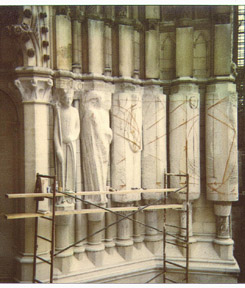
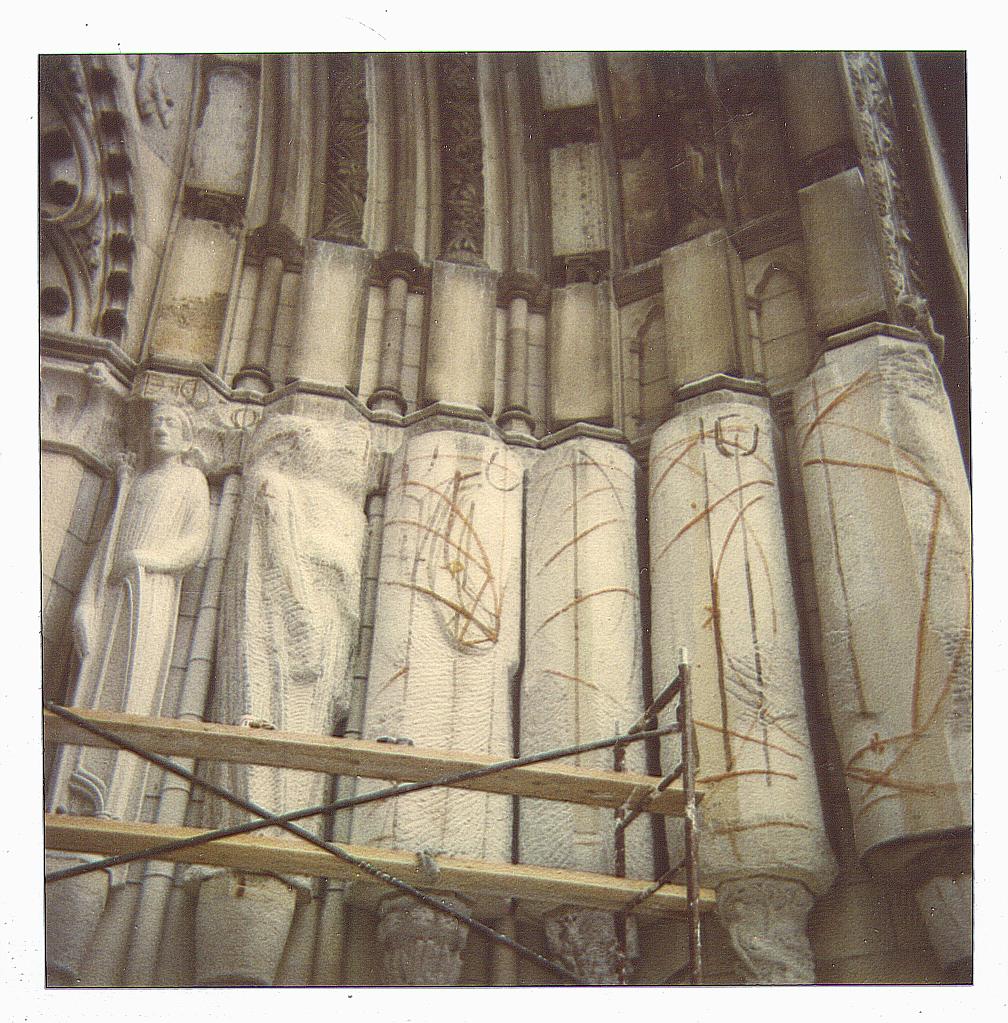
Here are some sketches Simon made for me which help explain his planning:


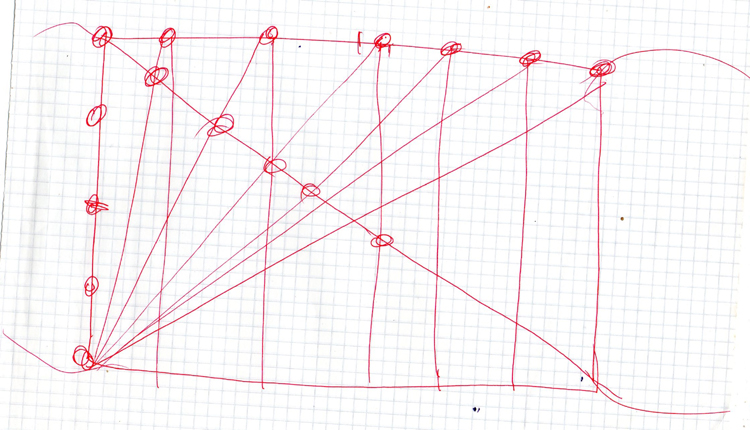
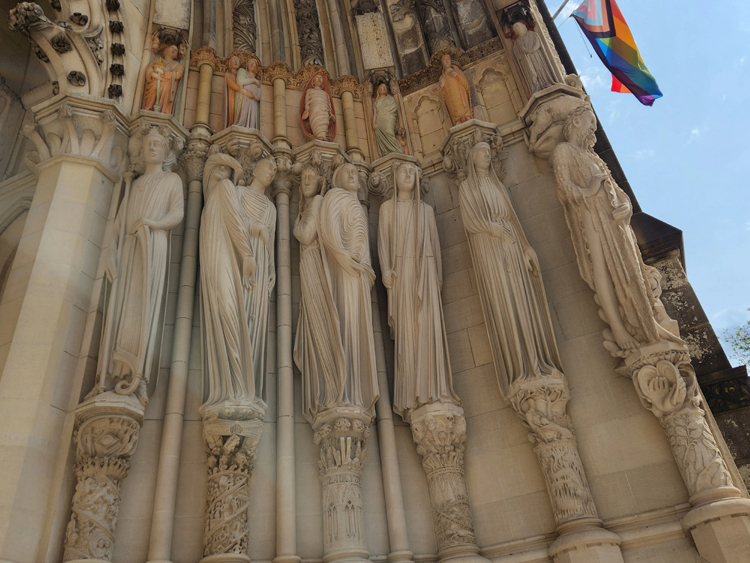 Completed 1997
Completed 1997
One interesting but never-published fact deriving from this geometric scheme that Simon materialized brilliantly is this: as you walk from the street up the stairs eastward toward the central entrance, the Portal of Paradise, you may notice how he used the geometry I had shown him, and his exquisite carving skills, to direct the eyes of the statues to follow you in sequence as you approach and pass them by, one by one, each statue welcoming you through each next section of your approach to the Portal! You can get a sense of this by noticing the directions each of the faces look in the finished sculptures above. Wow! I had never heard of this type of thing before in any Cathedral or anywhere! A true master stonecarver indeed!
I was honored to receive from Simon this drawing and his very kind note:


In August, 2024, I was saddened to learn of Simon's passing, and most surprised and honoured to see my name mentioned in Simon's obituary. Rest In Peace and Cathedrals of Light, my friend.
The Cathedral Of St. John The Divine is a marvel of design in whole and part. At 601 feet (the length of two American football fields, plus one football) it is the world's largest Gothic Cathedral. It was designed in modern times by architects familiar with the 13th century High Gothic style of northern France. Its roles in the community, city, nation and world are priceless. In 2003, the Cathedral was designated a landmark by the New York City Landmarks Preservation Commission.
The word Cathedral means "seat of the bishop" and is related to the mathematical word "polyhedral" ["many seats" or faces, of a three-dimensional structure bounded by polygons]. So hedron = "seat".
West Rose Window
One of this Cathedral's key features is its west Rose Window placed above the main entrance, the Portal of Paradise, absorbing the light of the afternoon and setting sun. From inside, the rose window appears magnificent in its design, with colorful solar radiance bathing the congregation in a glorious pattern of light.
Like all classically designed Rose Windows, it displays a very definite geometric design. If you gaze at it as a kind of mandala, it may come to your attention that it is based on a four-fold symmetry which reaches towards eight and then sixteen directions.
To understand its geometry, we must first begin with eight equally-spaced points around a circle.
Connect every third point to draw this octagram star.
The Rose Window will be inscribed within the octagon at its center.
Many people are surprised to see that a Rose Window is usually a small part of a much larger construction. But this is often the case. Click here to see that the Rose Windows at Chartres Cathedral are also designed this way, although not based on the number eight (2x4) but on its close cousin twelve (3x4).
The crossings of the octagram star become the centers of eight overlapping circles whose radii reach into the inscribed circle of the Rose Window.
These eight circles show us the curves of the window's outermost design.
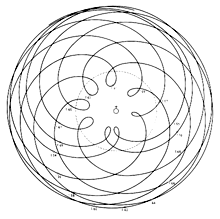
This eightfold design is reminiscent of an idealized version of the retrograde pattern of the planet Mars as seen from Earth, where Mars appears to make eight loops over sixteen years.
Let's look now at only the Rose Window at the construction's center.
A square has been inscribed around the window.
The square's diagonals and horizontal and vertical bisectors divide the circle into eight equally spaced points.
These line segments and an octagram star inscribed within begin to show us more of the window's design.
Eight line segments radiating from the center to the crossings of the octagram star show us how the central portion is divided into sixteen divisions.
Connecting the crossings of this octagram star gives us another octagram (yellow), which further subdivides significant areas.
Notice how the central octagon circumscribes the circle of stained glass.
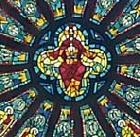 The crossings of this octagram star become the centers of four large circles (red) inscribed within the circle of the Rose Window.
The crossings of this octagram star become the centers of four large circles (red) inscribed within the circle of the Rose Window.
A circle is inscribed at the center tangent to the four larger circles. This reveals the circle at the center of the Rose Window.
Curiously, this same lovely geometric construction has been shown by John Martineau in his great work "A Little Book Of Coincidence" as the relative orbits of Earth and Mars (the large inner and outer circles) with 99.9% accuracy.
Observe the sacred architecture of every religion and you will see many examples of the interplay of circle, square and octagon, the symbols of heaven, earth, and mediation between them.
An octagon mediates between the heavenly circle and earthly square because it partakes of both: it is a square which has turned (90 degrees) along a circle. All the geometric details of this window may be found from the lines and points coming from the basic Octagram construction.
Through its geometric symbolism, the Rose Window announces the Cathedral as a place of mediation between Heaven and Earth.
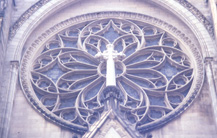
This view of the Rose Window from the Cathedral's outside confirms this geometric structure. Like many Rose Windows in Cathedrals around the world, a view of them from the world outside the Cathedral is meant to be dull and gray. But when viewed from within the sacred space of the Cathedral we're drenched in color and light!
It has been my experience investigating the geometry of sacred architecture that a Rose Window often displays in miniature the geometry of the larger Cathedral! In modern terms, the Rose Window would be called a fractal of the Cathedral. Below (left) we expand this last geometric scheme of the Window (minus the small corner circles) as a square extending from the Cathedral's base to the top of it's two smaller central towers. Notice that the central yellow circle, which is tangent to the four larger blue circles, and which in the Window encloses central Christ, now becomes the size of the Window itself! In the illustration below, right, the lines which this geometry implies are drawn and extended. Notice that the diagonals of the square extend by arcs up to become the sides of a square-root-two rectangle in which further details of the Cathedral's plan may be found by drawing diagonals and arcs, and subdividing by squares and root-two rectangles.
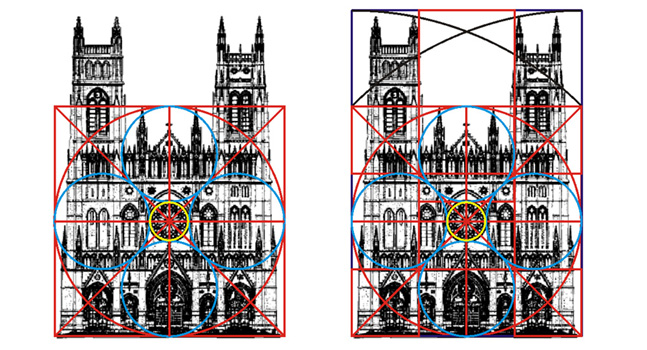
You might like to do this geometric construction on a blank sheet of paper and then use it to design your own Rose Window, or a Mandala, a building, or anything you like.
If you live in, or ever visit New York City, you will never forget a visit to the Cathedral of St. John the Divine and its sculptures and West Rose Window. It's at 1047 Amsterdam Avenue in the Morningside Heights neighborhood, between West 110th Street (also known as Cathedral Parkway), 112th Street (the center), and West 113th Street.
Useless fact: If find yourself at the corner of 112th St. and Broadway, look eastward you'll see the Cathedral rising in the distance above the trees. Also there, at the corner, you'll find Tom's Restaurant, the outside of which is seen as the diner in the Seinfeld.television show (but notice how they never show you the word "Toms").
The building of the Cathedral has been ongoing for well over a century. It has always relied on donations, so here's your chance to contribute towards its ongoing and completion!
To see more such geometric analyses, click on any of these:
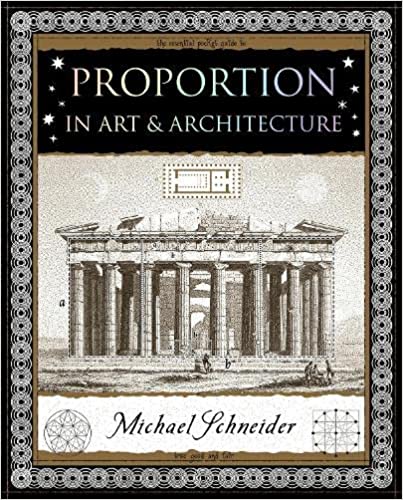
==================================